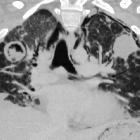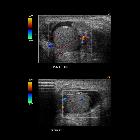ground-glass opacification



























Ground-glass opacification/opacity (GGO) is a descriptive term referring to an area of increased attenuation in the lung on computed tomography (CT) with preserved bronchial and vascular markings. It is a non-specific sign with a wide etiology including infection, chronic interstitial disease and acute alveolar disease.
Ground glass opacification is also used in chest radiography to refer to a region of hazy lung radiopacity, often fairly diffuse, in which the edges of the pulmonary vessels may be difficult to appreciate .
The use of the term ground glass derives from the industrial technique in glassmaking whereby the surface of normal glass is roughened by grinding it.
Pathology
Etiology
Ground-glass opacities have a broad etiology:
- normal expiration
- on expiratory acquisitions, which can be detected if the posterior membranous wall of the trachea is flattened or bowed inwards
- partial filling of air spaces
- partial collapse of alveoli
- interstitial thickening
- inflammation
- edema
- fibrosis
- lepidic proliferation of neoplasm
Morphological forms
- focal ground-glass opacification (i.e. ground-glass nodule)
- diffuse ground-glass opacification
- isolated diffuse ground-glass opacification
Differential diagnosis
Broadly speaking, the differential for ground-glass opacification can be split into :
- infectious processes (opportunistic vs non-opportunistic)
- chronic interstitial diseases
- acute alveolar diseases
- other causes
Infections
Opportunistic
- pneumocystis pneumonia (PCP/PJP)
- cytomegalovirus (CMV) pneumonia
- herpes simplex virus (HSV) pneumonia
- respiratory syncytial virus (RSV) bronchiolitis: type of infectious bronchiolitis
- other infectious causes
Non-opportunistic
Chronic interstitial diseases
- eosinophilic pneumonias: ground-glass opacification can be seen in many of the eosinophilic pneumonias but is most commonly seen in :
- simple pulmonary eosinophilia (SPE): nodules with a GGO halo
- idiopathic hypereosinophilic syndrome (IHS): nodules with a GGO halo
- acute eosinophilic pneumonia (AEP): bilateral patchy areas of GGO with interlobular septal thickening
- eosinophilic drug reactions: peripheral airspace consolidation and GGO
- idiopathic interstitial pneumonias
- non-specific interstitial pneumonia: GGO with linear or reticular markings, micronodules, consolidation, and microcystic honeycombing
- usual interstitial pneumonia (UIP): focal GGO with macrocystic honeycombing, reticular opacities, traction bronchiectasis, and architectural distortion
- cryptogenic organizing pneumonia (COP): formerly bronchiolitis obliterans with organizing pneumonia (BOOP); GGO with airspace consolidation and mild bronchial dilatation
- exudative phase of acute interstitial pneumonia (AIP): diffuse lung consolidation with GGO
- respiratory bronchiolitis-associated interstitial lung disease (RB-ILD): patchy GGO centrilobular nodules and bronchial wall thickening
- desquamative interstitial pneumonia (DIP): GGO with linear or reticular opacities
- lymphoid interstitial pneumonia (LIP): GGO often in association with perivascular cystic lesions, septal thickening, and centrilobular nodules
- sarcoidosis (pulmonary manifestations of sarcoidosis)
Acute alveolar disease
- alveolar edema or pulmonary edema
- hypersensitivity pneumonitis: especially acute and subacute forms
Other causes
- neoplastic processes with a lepidic proliferation pattern
- atypical adenomatous hyperplasia
- localized adenocarcinoma
- adenocarcinoma in situ or minimally invasive (formerly bronchoalveolar cell carcinoma)
- drug toxicity
Rare causes
- focal interstitial fibrosis: a non-neoplastic entity with a nodular ground-glass opacity that does not change over a long period of time; can be mistaken for a neoplastic process
- aspergillosis: a nodule with surrounding ground-glass opacity (CT halo sign) is rare except in severely immunocompromised patients
- thoracic endometriosis
- traumatic lung injury (pulmonary contusion)
- poisoning e.g. acute/subacute phase of paraquat poisoning
- pulmonary cryptococcus infection: solitary or multiple pulmonary nodules with or without peripheral GGO
- granulomatosis with polyangiitis
- Henoch-Schönlein purpura
- metal fume fever
See also
Siehe auch:
- Sarkoidose
- Kryptogene organisierende Pneumonie (COP)
- acute respiratory distress syndrome (ARDS)
- Granulomatose mit Polyangiitis
- Honigwabenmuster
- In Situ Adenokarzinom der Lunge
- pulmonale und mediastinale Sarcoidose
- Lungenkontusion
- lymphozytisch interstitielle Pneumonie
- vaping-induced acute lung injury (EVALI)
- Pneumocystis jiroveci Pneumonie
- gewöhnliche interstitielle Pneumonie (UIP)
- Milchglasherd
- non specific interstitial pneumonia (NSIP)
- idiopathic hypereosinophilic syndrome
- pulmonale Eosinophilie
- aspergillosis
- Akute interstitielle Pneumonie
- acute eosinophilic pneumonia (AEP)
- diffuse ground glass nodules
- Desquamative interstitielle Pneumonie (DIP)
- respiratory bronchiolitis–associated interstitial lung disease
- Halozeichen Lunge
- infective bronchiolitis
- Idiopathische interstitielle Pneumonie
- IgA-Vaskulitis
und weiter:
- mosaikartige Verdichtungen der Lunge
- Hypersensitivitätspneumonitis
- umgekehrtes Halozeichen Lunge
- reverse halo sign
- angioinvasive pulmonale Aspergillose
- Alveolarproteinose
- Sjögren-Syndrom
- pulmonary opacification
- lung torsion
- diffuse idiopathische pulmonale neuroendocrine Zellhyperplasie
- infectious bronchiolitis
- Strahlenpneumonitis
- alveoläre Mikrolithiasis
- bronchus associated lymphoid tissue lymphoma
- HRCT terminology
- Kaposisarkom
- sub acute extrinsic allergic alveolitis
- byssinosis
- acute eosinophilic pneumonia
- eosinophile Granulomatose mit Polyangiitis
- pulmonale Manifestationen der Leukämie
- head cheese sign
- follikuläre Bronchiolitis
- diffuses Milchglasphänomen
- neuroendokrine Zellhyperplasie des Kindes

 Assoziationen und Differentialdiagnosen zu Milchglasverschattungen:
Assoziationen und Differentialdiagnosen zu Milchglasverschattungen:




















